
table of contents
- Dry locations
- Perennials from A to J
- Perennials from K to O
- Perennials from P to R
- Perennials from S to Z
- Planting plan
- frequently asked Questions
Perennial beds are great eye-catchers in the garden. Since the selection of perennials is almost endless, they can be designed according to your taste. But what if they are dry locations? Find out which perennials you can plant in dry locations here.
In a nutshell
- dry locations are not just stone structures
- large selection of perennials for dry locations
- The trend is for perennial beds with one or two grasses
Dry locations
Sunny, dry locations are for example
- Rock steppes
- Stone plants
- Open spaces with a steppe-heather character, but also
- Open spaces with just plain dry soil
There are also places in the garden where rain only sparsely or not at all, such as under eaves. Elsewhere, the heat in summer dries out the soil more and more, so that many of the conventional perennials do not really want to grow there. You can plant the following perennials in dry locations.
Perennials from A to J
Branchy grass lily (Antherium ramosum)
- Height: 50 to 60 centimeters
- Flower: white
- Flowering period: June - August
- Winter hardiness: -23.4 degrees Celsius
- Plant partners: round-leaved bellflower, diptame, flower dost

Affodil (Asphodelus albus)
- Height: 30 to 100 centimeters
- Flower: white, delicate, lily-like
- Flowering period: May - July
- Winter hardiness: down to -23.4 degrees Celsius
- Plant partner: Junker lily

Knotless grass lily (Anthericum liliago)
- Height: 40 to 50 centimeters
- Flower: white
- Flowering period: May - June
- Winter hardiness: -23.4 degrees Celsius
- Plant partners: bluetongue leek, coastal sea kale, Spanish noble thistle

Argentine verbena (Verbena bonariensis)
- Height: 80 to 120 centimeters
- Flower: blue-violet
- Flowering period: July - October
- Winter hardy: down to -12.3 degrees Celsius
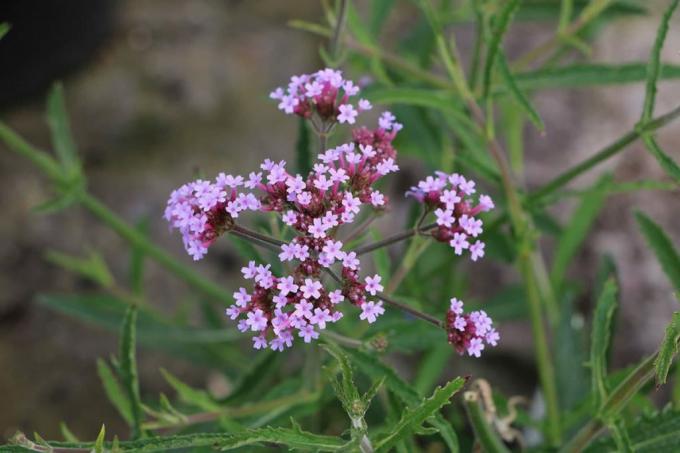
Baikal skullcap (Scutellaria baicalensis)
- Height: 20 to 30 centimeters
- Flower: purple
- Flowering period: July - September
- Winter hardiness: -28.8 degrees Celsius
- Plant partner: mouse ear
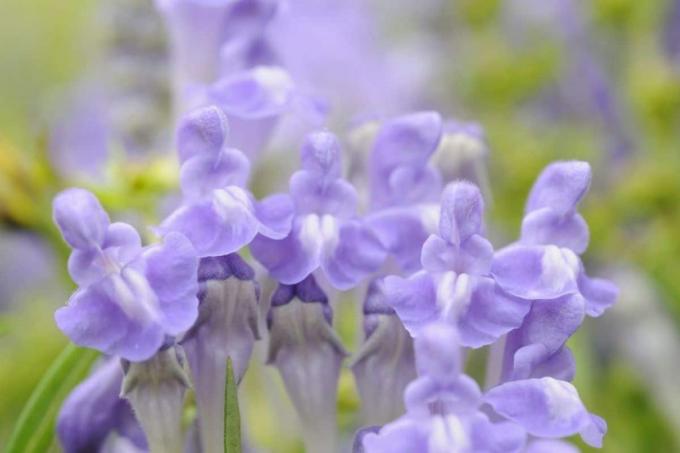
Rush Lily (Sisyrinchium striatum)
- Growth height: up to 50 centimeters
- Flower: yellow-white to golden-yellow
- Flowering period: May - July
- Winter hardiness: -12.2 degrees Celsius
- Plant partner: rose leek
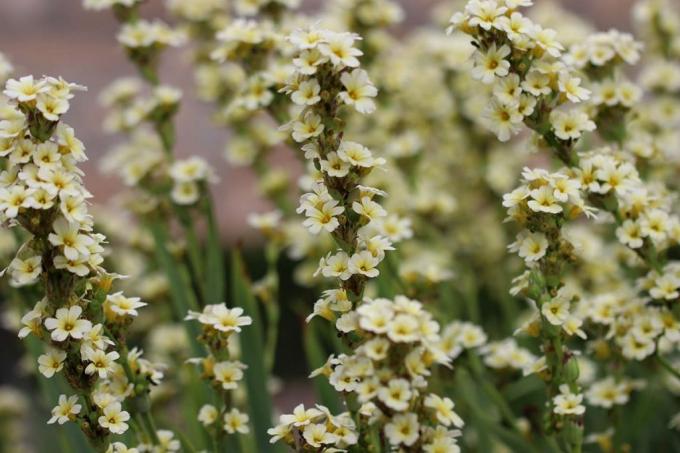
Thorny Restharrow (Ononis spinosa)
- Height: 20 to 60 centimeters
- Flower: pink-red
- Flowering period: June - August
- Winter hardiness: -23.4 degrees Celsius
- Plant partners: Karthauser carnation, meadowsweet, eyelash pearl grass

Scented nettle (Agastache rugosa hybrid)
- Height: 70 to 90 centimeters
- Flower: blue-violet
- Flowering period: July - September
- Winter hardiness: -23.4 degrees Celsius
- Plant partner: splendid candle
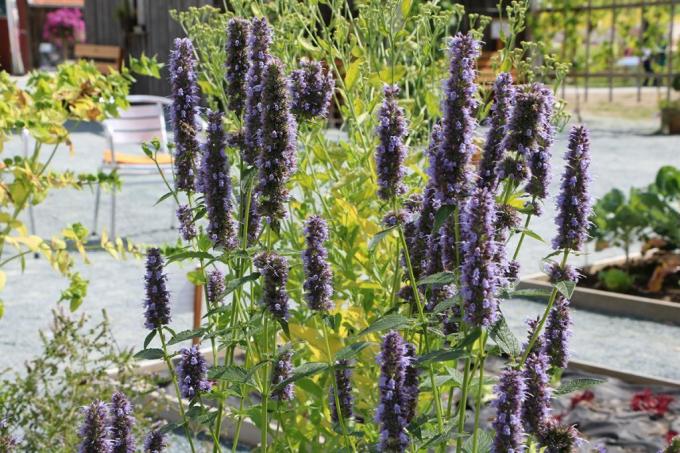
Gold flax "Compactum" (Linum flavum "Compactum")
- Growth height: up to 20 centimeters
- Flower: yellow
- Flowering period: June - August
- Winter hardiness: -23.4 degrees Celsius
- Plant partners: golden-haired aster, blue fescue "Ellijah Blue", garden lavender, pasque flower

Golden-haired aster (Aster linosyris)
- Height: 50 to 60 centimeters
- Flower: golden yellow
- Flowering period: August - October
- Winter hardiness: -34.5 degrees Celsius
- Plant partner: Dyer's chamomile, little meadowsweet, blood cranesbill

Gray holy herb (Santolina chamaecyparissus)
- Height: 30 to 50 centimeters
- Flower: yellow
- Flowering period: July - August
- Winter hardiness: -17.8 degrees Celsius
- Plant partners: garden lavender, blue rue, clary sage

Perennials from K to O
Candelabra mullein (Verbascum olympicum)
- Growth height: up to 180 centimeters
- Flower: yellow
- Flowering period: June - August
- Winter hardiness: -23.4 degrees Celsius
- Plant partners: light dyer's chamomile, branchy grass lily, blue-ray oat, meadow sage

Hybrid catnip (Nepeta x faassenii)
- Height: 80 to 90 centimeters
- Flower: violet-blue
- Flowering period: May - July
- Winter hardiness: -34.5 degrees Celsius
- Plant partners: gray chamomile, knotty grass lily, cotton ziest

Little goldenrod (Solidago cutleri)
- Height: 20 to 40 centimeters
- Flower: yellow
- Flowering period: July - September
- Winter hardiness: down to -34.5 degrees Celsius

Cinderella (Phlomis tuberosa)
- Height: 80 to 120 centimeters
- Flower: pink-purple-violet
- Flowering period: June - July
- Winter hardiness: down to -28.8 degrees Celsius
- Plant partner: purple-spice-sage, whorled sage

Pasque Flower (Pulsatilla vulgaris)
- Growth height: up to 20 centimeters
- Flower: purple
- Flowering period: March - April
- Winter hardiness: down to -28.8 degrees Celsius
- Plant partner: gold flax

Note: The pasque flower is slightly poisonous.
Junker Lily (Asphodeline lutea)
- Height: 50 to 100 centimeters
- Flower: yellow
- Flowering period: May - June
- Winter hardiness: down to -23.4 degrees Celsius
- Plant partners: Affodil, spring fingerwort, silver mullein

Globe thistle (Echinops bannaticus)
- Height: 80 to 120 centimeters
- Flower: blue
- Flowering period: July - September
- Winter hardiness: down to -34.5 degrees Celsius
- Plant partner: splendor candle, yellow scabiosa
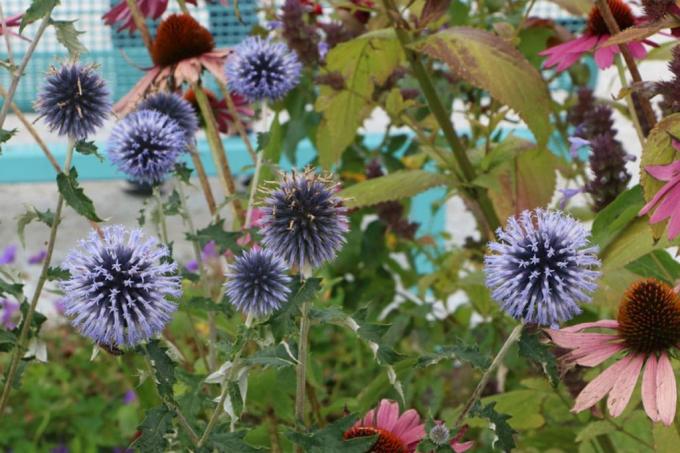
Bay-leaved rockrose (Cistus laurifolius)
- Height: 60 to 120 centimeters
- Flower: white
- Flowering period: June - August
- Winter hardiness: down to -17.8 degrees Celsius
- Plant partner: small blue rhombus

Mouse ear (Marrubium vulgare)
- Height: 40 to 60 centimeters
- Flower: white
- Flowering period: June - August
- Winter hardiness: down to -40.1 degrees Celsius
- Plant partners: stone whorl, shrub-everlasting flower, grape-catnip, Nevada-sage
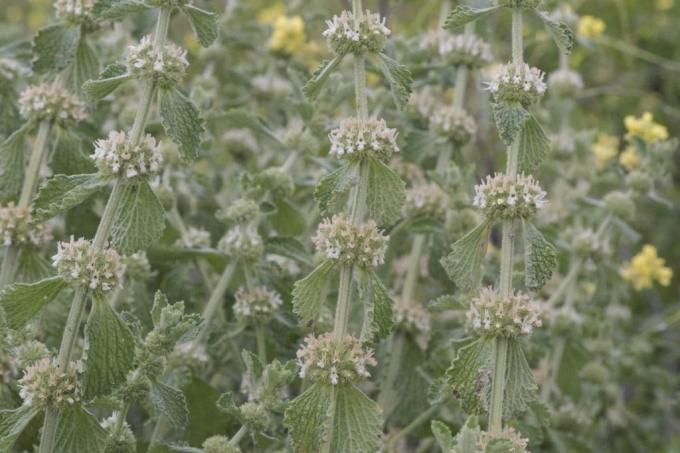
Note: The mouse ear is slightly poisonous.
Olive herb (Santolina rosmarinifolia)
- Height: 30 to 60 centimeters
- Flower: yellow
- Flowering period: June - August
- Winter hardiness: down to -17.8 degrees Celsius
- Plant partner: garden lavender, dwarf spice sage

Perennials from P to R
Magnificent candle (Gaura lindheimeri)
- Height: 60 to 100 centimeters
- Flower: depending on the variety
- Flowering period: July - October
- Winter hardiness: down to -17.8 degrees Celsius
- Plant partner: Patagonian verbena (Verbena bonariensis)
- Flavors: Cool Breeze and Whirling Butterflies (white), Gambit Rose (dark pink-red), Siskiyou Pink (pink)

Magnificent sedum plant (Hylotelephium spectabile)
- Height: 30 to 40 centimeters
- Flower: white to pink
- Flowering period: August - September
- Winter hardiness: down to -28.8 degrees Celsius
- Plant partner: garden riding grass

Note: The magnificent sedum plant is often still sold under its old botanical name Sedum spectabile.
Purple Mullein (Verbascum phoeniceum)
- Height: 60 to 90 centimeters
- Flower: purple, pink, red, white
- Flowering period: May - June
- Winter hardiness: down to -23.4 degrees Celsius
- Plant partner: palm lily

Purple coneflower (Echinacea purpurea)
- Height: 60 to 90 centimeters
- Flower: purple-pink
- Flowering period: July - September
- Winter hardiness: down to -40.1 degrees Celsius
- Plant partner: purple scabious
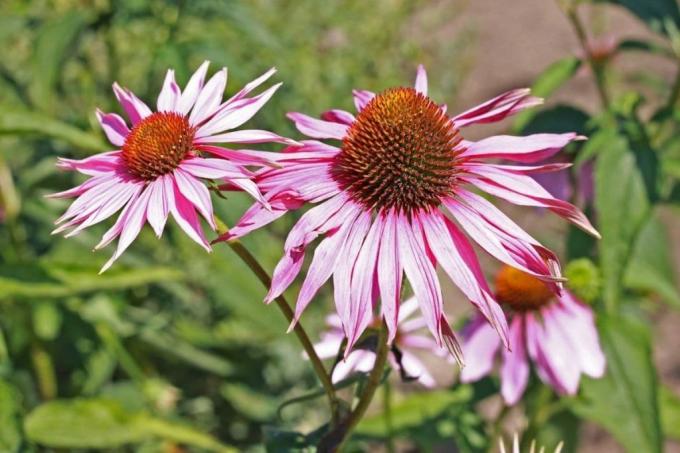
Perennials from S to Z
Sand carnation (Dianthus arenarius)
- Height: 10 to 20 centimeters
- Flower: white
- Flowering period: July - September
- Winter hardiness: down to -40.1 degrees Celsius
- Plant partners: heather carnation, dwarf blue fescue "dwarf king", tripmadam

Velvet Carnation (Lychnis coronaria)
- Height: 60 to 80 centimeters
- Blossom: chimney red
- Flowering period: June - July
- Winter hardiness: down to -34.5 degrees Celsius
- Plant partner: white meadow sage
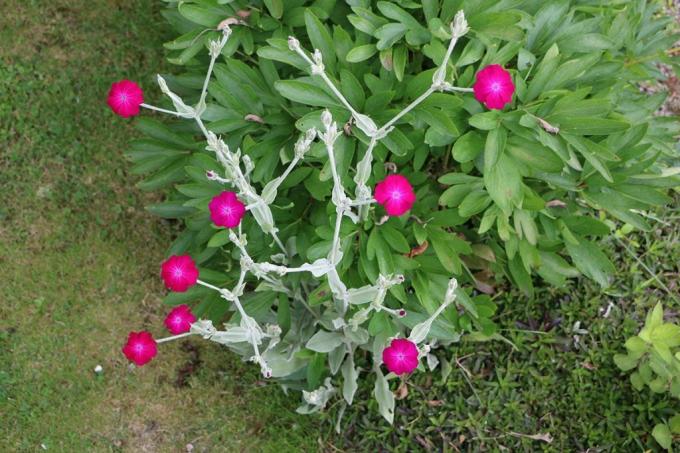
Note: The velvet carnation is also available with white flowers.
Cobweb houseleek (Sempervivum arachnoideum ssp. Tomentosum)
- Height: 5 to 10 centimeters
- Blossom: chimney red
- Flowering period: June - July
- Winter hardiness: -28.8 degrees Celsius
- Plant partner: Blue fescue "Elijah Blue", stuffed rock carnation, spicy stonecrop

Perennial flax (Linum perenne)
- Height: 25 to 50 centimeters (depending on the variety)
- Flower: white or sky blue (depending on the variety)
- Flowering period: June - August
- Winter hardiness: -34.5 degrees Celsius
- Plant partners: purple toadflax, white carnation, yellow scabiosa
- Types: Naum Diamant (white), Nanum Saphir (sky blue)

Stone Quendel (Calamintha nepeta)
- Height: 30 to 50 centimeters
- Flower: whitish
- Flowering period: July - October
- Winter hardiness: down to -23.4 degrees Celsius
- Plant partner: Junker lily

Shrub everlasting flower (Helichrysum italicum)
- Height: 40 to 50 centimeters
- Flower: yellow
- Flowering period: July - September
- Winter hardiness: down to -17.8 degrees Celsius
- Plant partners: blue hyssop, flower dost, gray upholstered thyme
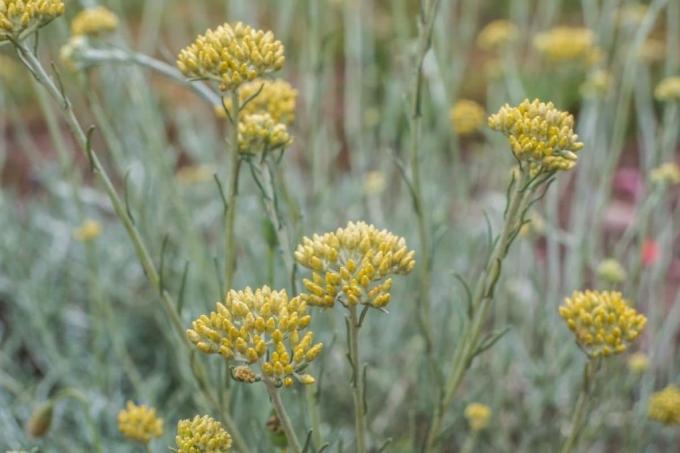
Woolen ziest (Stachys byzantina)
- Height: 40 to 60 centimeters
- Flower: lilac-pink
- Flowering period: June - July
- Winter hardiness: down to -28.8 degrees Celsius
- Plant partner: scented nettle, stone whale
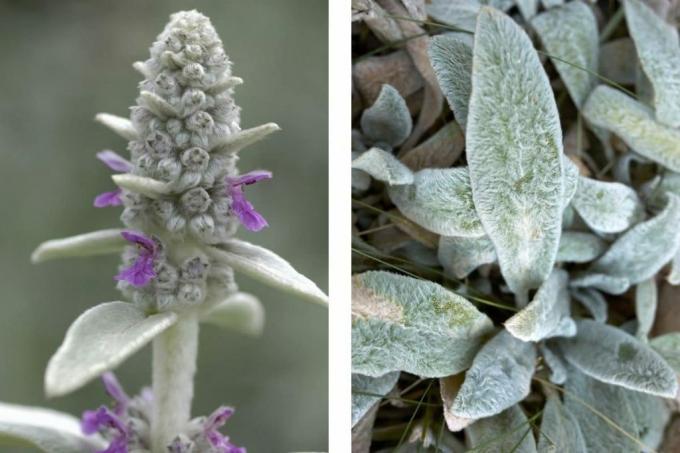
Planting plan
The following planting plan refers to a rectangular bed, with the width being the longer side and the length being the shorter side. So that you can later position the perennials correctly on the plan for dry locations, divide the length of the rectangle into three areas:
- a narrower zone (front)
- a more prepared zone (middle)
- a narrower zone (rear)
Now place the perennials in each zone from left to right.
Front zone:
- Rush lily
- Steinquendel
- Woll-Ziest
Middle zone:
- Rush lily
- Giant feather grass (Stipa gigantea)
- Hybrid catnip with purple coneflower behind
- Magnificent sedum plant, behind garden saddle grass (Calamagrostis x acutiflora "Karl Foerster")
Back zone:
- Globe thistle
- Splendid candle
- Garden riding grass
- Scented nettle
frequently asked Questions
Yes there is. However, the selection of perennials here is significantly less than in sunny places. For the Penumbra For example, summer forest aster (Aster divaricatus), nettle bellflower (Campanula trachelium), carpet clematis (Clematis x jouiniana) are suitable.
Yes, the shape of the bed has no influence on the soil. So that the perennial bed comes into its own, plant from the outside in. This means that the perennials get higher from the edge towards the center.
Yes, mulching is allowed. It even has the advantage that the growth of weeds is dampened. Unfortunately, this plague also occurs in dry locations.



